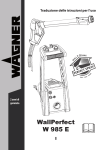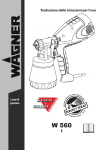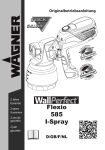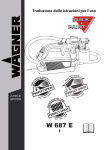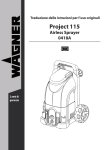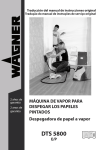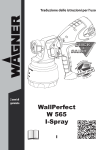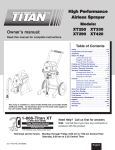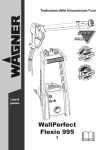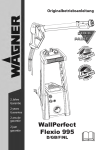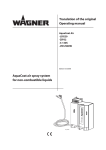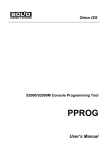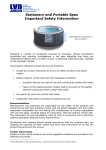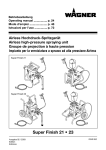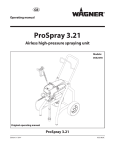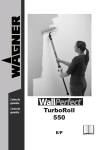Download Wagner Project Pro 117
Transcript
® Translation of the original operating instructions ProjectPro 117 Airless Sprayer 0418B Owner’s Manual GB Wagner Project Pro 117 - 0418B 1 D I A B C E F J G H 2 3 1) 2) 4 1) (a) 5 1) 6 2) 1) 2 3) SPRAY O PRIME 2) 2) Wagner Project Pro 117 - 0418B 7 2) + l 4) 5) PRIME 3) (a) SPRAY 1) (b) 8 9 2) PRIME SPRAY 1) 3) (a) l (b) SPRAY PRIME 10 B) A) 25 - 30 cm C) D) 25 - 35 cm 25 - 30 cm 3 25 - 30 cm Wagner Project Pro 117 - 0418B 11 12 A) B) 13 1) 3) 2) A) B) 14 (b) (c) (a) 15 (g) (e) (f) (d) (a) (c) (b) 4 Wagner Project Pro 117 - 0418B 16 17 18 1) (a) 2) (a) (b) 19 20 1 2 4 21 7 8 4 3 2 1 5 10 9 11 6 5 3 Wagner Project Pro 117 - 0418B - Safety Information Warning! Attention: Danger of injury by injection! Airless units develop extremely high spraying pressures. Danger 1 Never put your fingers, hands or any other parts of the body into the spray jet! Never point the spray gun at yourself, other persons or animals. Never use the spray gun without safety guard. Do not treat a spraying injury as a harmless cut. In case of injury to the skin through coating materials or solvents, consult a doctor immediately for quick and expert treatment. Inform the doctor about the coating material or solvent used. 2 The operating instructions state that the following points must always be observed before starting up: 1. Faulty units must not be used. 2. Secure WAGNER spray gun using the safety catch on the trigger. 3. Ensure that the unit is properly earthed. The connection must take place through a correctly earthed two-pole and earth socket outlet. 4. Check allowable operating pressure of high-pressure hose and spray gun. 5. Check all connections for leaks. 3 The instructions regarding regular cleaning and maintenance of the unit must be strictly observed. Before any work is done on the unit or for every break in work the following rules must be observed: 1. Release the pressure from spray gun and hose. 2. Secure the WAGNER spray gun using the safety catch on the trigger. 3. Switch off unit. Be safety-conscious! 6 Wagner Project Pro 117 - 0418B - Safety Information General Safety Instructions 3. Safety of Persons Read all the instructions. Non-observance of the instructions below can cause electric shock, fire and or serious personal injuries. The term „power tool“ used below covers both mains-operated power tools (with mains lead) and accumulator-operated power tools (without mains lead). All local regulations in force must be observed. a) Be attentive. Pay attention to what you are doing and work sensibly with a power tool. Do not use the tool if you are tired or under the influence of drugs, alcohol or medication. Just a moment of inattentiveness while using the tool can lead to serious injuries. b) Wear personal safety equipment and always wear safety goggles. Wearing personal protective equipment, such as dust mask, non-slip safety shoes, safety helm or ear protection, depending on the type of power tools, reduces the risk of injury. Explanation of symbols used Indicates an immediate danger. Unless avoided, death or serious injuries will result. c) Avoid accidental starting-up. Ensure that the switch is in the "OFF" position before inserting the plug into the socket. Accidents can occur if you carry the power tool while your finger is on the switch or if you connect the power tool to the power supply which it is on. Danger i Indicates tips for use and other particularly useful information. d) Remove setting tools or wrenches before switching on the power tool. A tool or wrench that is in a rotating tool part can lead to injuries. Explosion hazard. e) Do not overestimate your abilities. Ensure that you are standing securely and have your balance at all times. This ensures that you can control the tool better in unexpected situations. Attention: Danger of injury by injection! f) Wear suitable clothing. Do not wear wide clothing or jewelry. Keep your hair, clothes and gloves away from moving parts. Loose clothing, jewelry or long hair can be caught in moving parts. 1. Workplace a) Keep your workplace clean and tidy. Untidiness and unlit working areas can lead to accidents. g) This appliance is not intended for use by persons (including children) with reduced physical, sensory or mental capabilities, or lack of experience and knowledge, unless they have been given supervision or instruction concerning use of the appliance by a person responsible for their safety. Children should be supervised to ensure that they do not play with the appliance. b) Never use the tool in hazardous areas that contain flammable liquids, gases or dusts. Power tools generate sparks that can ignite the dust or vapors. c) Keep children and other persons away when using the power tool. You can lose control of the tool if you are distracted. 2. Electrical Safety 4. Careful Handling and Use of Power Tools a) The tool plug must fit into the socket. The plug may not be modified in any form. Do not use adaptor plugs together a) Do not overload the tool. Use the power tool designed for the work that you are doing. You work better and safer in the specified performance range if you use the suitable power tool. with protective-earthed tools. Unmodified plugs and suitable sockets reduce the risk of an electric shock. b) Avoid physical contact with earthed surfaces such as pipes, heating elements, stoves and refrigerators. The risk through electric shock increases if your body is earthed. b) Do not use power tools whose switch is defective. A power tool that cannot be switched on or off is dangerous and has to be repaired. c) Keep the equipment away from rain and moisture. The risk of an electric shock increases if water penetrates electrical equipment. c) Remove the plug from the socket before carrying out tool settings, changing accessories or putting the tool away. This precautionary measure prevents unintentional starting of the tool. d) Do not misuse the mains lead by carrying the tool by the lead, hanging it from the lead or by pulling on the lead to remove the plug. Keep the lead away from heat, oil, sharp edges or moving tool parts. Damaged or twisted leads increase the risk of an electric shock. d) Store unused power tools so that they are inaccessible to children. Do not let persons use the tool who are not familiar with it or who have not read these instructions. Power tools are dangerous when they are used by inexperienced persons. e) If you work outdoors, use only extension leads that are approved for outdoor use. The use of an extension lead that is suitable for outdoors reduces the risk of an electric shock. e) Take proper care of your tools. Check whether the moving parts function trouble-free and do not jam, whether parts are broken or damaged so that the tool function is impaired. Have damaged parts repaired before using the tool. Many accidents have their origin in power tools that have been 7 Wagner Project Pro 117 - 0418B - Safety Information maintained badly. a) Have your tool repaired only by qualified specialist personnel and only with original spare parts. This ensures that the tool safety is maintained. b) If the supply cord is damaged, it must be replaced by the manufacturer or it’s service agent or a similarly qualified person in order to avoid a safety hazard. Caution! Wear breathing equipment: Paint mist and solvent vapors are damaging to health. Always wear breathing equipment and only work in well ventilated rooms or using supplementary ventilating equipment. It is advisable to wear working clothing, safty glasses, ear protection and gloves U Max. operating pressure Coating substance Caution against dangers that can arise from the sprayed substance and observe the text and information on the containers or the specifications given by the substance manufacturer. Only use coating materials with a flash point of 21 °C or above without additional heating. The flash point is the lowest temperature at which vapors develop from the coating material. These vapors are sufficient to form an inflammable mixture over the air above the coating material. Do not spray any liquid of unknown hazard potential. U High-pressure hose (safety note) Electrostatic charging of spray guns and the high-pressure hose is discharged through the high-pressure hose. For this reason the electric resistance between the connections of the high-pressure hose must be equal or lower than 197 kΩ/m (60 kΩ/ft.). Do not use the unit in work places which are covered to the explosion protection regulations. i Danger of explosion and fire through sources of flame during spraying work Danger In case of high operating pressure, pulling the trigger can effect a recoil force of up to 15 N. If you are not prepared for this, your hand can be thrust backwards or your balance lost. This can lead to injury. Continuous stress from this recoil can cause permanent damage to health. Max. permissible operating pressure for spray gun, spray gun accessories and high-pressure hose may not fall short of the maximum operating pressure of 200 bar (20 MPa) stated on the unit. Explosion protection Danger U There may be no sources of flame such as, for example, open fires, smoking of cigarettes, cigars or tobacco pipes, sparks, glowing wires, hot surfaces, etc. in the vicinity. For reasons of function, safety and durability, only use genuine WAGNER high-pressure hoses and spray nozzles. For overview see „Spare parts lists“. Connecting the device A properly earthed socket outlet with earthing contact must be used for connection. The connection must be equipped with a residual current protective device with INF ≤ 30 mA. U Electrostatic charging (formation of sparks or flame) Setting up the unit When working indoors: Vapors containing solvents may not be allowed to build up in the area of the device. Setting up the unit on the side a way from the sprayed Danger object. A minimum distance of 5 m between the unit and spray gun is to be maintained. Under certain circumstances, electrostatic charging can occur on the unit due to the rate of flow of the coating material when spraying. On discharging this Danger can result in the emergence of sparks or fire. It is therefore necessary that the unit is always earthed through the electrical installation. The connection must take place through a correctly earthed two-pole-and-earth socket outlet. Recoil of spray gun U Flash point Danger U U Health protection Danger U Secure device and spray gun Danger For secure handling of Airless high-pressure spraying units the following safety regulations are to be observed: U U All hoses, fittings, and filter parts must be secured before operating spray pump. Unsecured parts can eject at great force or leak a high pressure fluid stream causing severe injury. Always secure the spray gun when mounting or dismounting the tip and in case of interruption to work. 5. Service U Ventilation Good natural or artificial ventilation must be ensured in order to avoid the risk of explosion or fire and damage to health during spray work. f) Use the power tool, accessories, insert tools, etc. in accordance with these instructions and in a fashion specified for this special tool type. Take the working conditions and the activity to be carried out into consideration. The use of power tools for purposes other than the intended ones can lead to dangerous situations. U U 8 Wagner Project Pro 117 - 0418B U When working outdoors: Vapors containing solvents may not be allowed to blow toward the unit. Note the direction of the wind. Set the unit up in such a way that vapors containing Danger solvents do not reach the unit and build up there. A minimum distance of 5 m between the unit and spray gun is to be maintained. U Danger Cleaning the unit Danger Cleaning units with solvents U Danger of short circuit through penetrating water! Never spray down the unit with high-pressure or high-pressure steam cleaners. When cleaning the unit with solvents, the solvent should never be sprayed or pumped back into a container with a small opening (bunghole). An explosive gas/air mixture can be produced. The container must be earthed. Do not clean the device or accessories with flammable solvents with a flash point below 21 °C. Earthing of the object The object to be coated must be earthed. Components and Description The shipping carton for your painting system contains the following: •Suction tube and return tube (including inlet filter and 3 clips) • Spray tip assembly • Basic unit • 7.5 m, 6.35mm internal diameter pressure hose • Spray gun with two filters (L-XXL; one in gun, one separate) • Oil flask • Instruction manual Figure 1 - Controls and Functions (further, detailed descriptions of the individual items can be found in the relevant section of the operating instructions) Item Component Description A) ON / OFF Switch����������������������������The ON/OFF switch turns the power to the sprayer on and off (O=OFF, l=ON). B) PRIME / SPRAY Knob��������������������The PRIME/SPRAY knob directs fluid to the spray hose when set to SPRAY or the return tube when set to PRIME. The arrows on the PRIME/SPRAY knob shows the rotation directions for PRIME and SPRAY. The PRIME/SPRAY knob is also used to relieve pressure built up in the spray hose (see Pressure Relief Procedure). C) Quickflo™ Valve�����������������������������The Quickflo™ valve is designed to keep the inlet valve open and from sticking to dried materials. The Quickflo™ valve is activated manually by the user. D) PressureTrac™��������������������������������The PressureTrac™ regulates the amount of force the pump uses to push the fluid. E) Pump Section���������������������������������A piston in the pump section moves up and down to create the suction that draws fluid through the suction tube. F) Suction Tube����������������������������������Fluid is drawn through the suction tube into the pump. G) Return Tube������������������������������������Fluid is sent back out through the return tube to the original container when PRIME/SPRAY knob is in PRIME position. H) Inlet filter������������������������������������������The inlet filter strains the spray material to prevent the system from becoming clogged. I) Spray Gun����������������������������������������For application of the coating material and regulation of the pump capacity. J) Spray Hose��������������������������������������The spray hose connects the gun to the pump. Pump type Power source Power consumption Fusing Coating Materials Suitable for Use Technical Data Piston pump 230-240 V ~ 50 Hz 670 W Only connect to sockets protected with an FI fuse (16 A) Water-based and solvent-containing lacquers and glazes. Paints, oils, release agents, synthetic enamels, PVC lacquers, undercoats, base coats, fillers and anti-rust paints. Dispersion and latex paints for interior use. Double insulation Max. spray pressure Max. delivery rate Sound pressure level Oscillation level Max. temperature of coating substance Max. nozzle size Hose length Weight Coating Materials Not Suitable for Use 200 bar 1,0 l/min 71,4 dB (A) < 2,5 m/s² Materials that contain highly abrasive components, facade paint, caustic solutions and acidic coating substances. Materials with a flash point below 21°C. 40°C XL (0,019") 7,5 m 7,8 kg i 9 In order to ensure compatibility of the coating substance with the materials used to manufacture the device, please contact Wagner Service in cases of doubt. Wagner Project Pro 117 - 0418B Field of application Figure 4 - Locking the Spray Gun Coating of interior walls as well as small and medium-sized objects outdoors (e.g. garden fences, garage doors, etc.). Danger Assembly Figure 2 - Attaching the Hose Danger Make sure that the pump is switched off (position O) and the spray device is disconnected from the power supply. Danger The spray tip should not be attached until after the sprayer and spray hose have been purged and primed. Figure 3 - Attaching the Suction Set 1. The gun is secured when the trigger lock is at a 90° angle (perpendicular) to the trigger in either direction. Figure 5 - Pressure Relief Procedure 1. Thread the high pressure hose to the spray hose port. Tighten with an adjustable wrench. 2. Thread the other end of the hose to the spray gun. Grip the spray gun with an adjustable wrench on the handle, and tighten the hose nut with the other. i Always lock the trigger off when attaching the spray tip or when the spray gun is not in use. Be sure to follow the Pressure Relief Procedure when shutting the unit off for any purpose. This procedure is used to relieve pressure from the spray hose. 1. Lock the spray gun off. Flip the ON/OFF switch to the OFF position. 2. Turn the PRIME/SPRAY knob to PRIME. 3. Unlock the spray gun and trigger spray gun into the side of the material bucket. Lock the spray gun. Priming 1. Remove cap from inlet valve (a). Thread the suction tube onto the inlet valve and tighten firmly by hand. Be sure that the threads are straight so that the fitting turns freely. 2. Push the return hose into the return connection piece. Figure 6 - Preparing to Prime Before You Begin 1. Spray a little oil out of the provided flask into the marked opening (tip: tilt the device back). Light household oil can be substituted if necessary. 2. Fully insert the Quickflo™ valve to make sure the inlet ball is free. Preparation of the Coating Material Figure 7 - Priming the Sprayer Using Project Pro 117 interior wall paints, varnishes and glazes can be applied by spraying without diluting them, or by diluting them slightly. Detailed information is available in the technical data sheet of the manufacturer ( Internet download). 1. Stir the material thoroughly and dilute it in the container as per the recommended dilution (an agitator is recommended for stirring). i Thinning recommendation Sprayed material Glazes Wood preservatives containing solvents or based on water, mordants, oils, disinfection agents, plant protective agents Paints containing solvents and water-soluble paints, primers, vehicle coating paints, thick-film glazes Interior wall paint (dispersions and latex paint) undiluted undiluted dilute by 5 - 10% The unit will begin to draw material up the suction tube, into the pump, and out the return tube. Let the unit cycle long enough to remove test fluid from the pump, or until spray material is coming from the return tube. 5. Switch the pump OFF (O). Remove the return tube from the waste container and place it in its operating position above the container of spraying material. Use the metal clip to bind the two hoses together. Figure 8 - Priming the Spray Hose dilute by 0 - 10% 2. Do a test spray (e.g. on to a piece of cardboard). i 1. Place a full container of spraying material underneath the suction tube (a). Secure the return tube (b) into a waste container. 2. Slide the PressureTrac™ to maximum pressure (+). 3. Turn the PRIME/SPRAY knob to PRIME. 4. Plug in the sprayer and move the ON/OFF switch to the ON (l) position. 1. Unlock the spray gun and turn the PRIME/SPRAY knob to PRIME. i If the paint sprays evenly, as shown in fig. 11 A, all the setting must be correct. If the paint looks stripy after spraying, as shown in fig. 11 B, gradually increase the pressure, or dilute more in 5% steps. 10 The spray tip should not be attached to your spray gun when purging your spray hose. 2. PULL the trigger and aim the spray gun at the side wall of a waste container. If using oil-based materials, the spray gun must be grounded while purging (see warning below). Wagner Project Pro 117 - 0418B Danger 3. While pulling the trigger, switch the pump ON (l), and turn the PRIME/SPRAY knob to Spray. Hold the trigger until all air, water, or solvent is purged from the spray hose and material is flowing freely. Danger Keep hands clear from fluid stream. Ground the gun by holding it against the edge of a metal container while flushing. Failure to do so may lead to a static electric discharge which may cause a fire. If the PRIME/SPRAY knob is still on SPRAY, there will be high pressure in the hose and spray gun until the PRIME/SPRAY knob is turned to PRIME. 4. Release trigger. Turn the prime/spray knob to PRIME. Turn the pump OFF (O). Trigger the gun into the waste container to be sure that no pressure is left in the hose. Figure 12 - Unclogging the Spray Tip i Figure 9 - Attaching the Spray Tip Danger POSSIBLE INJECTION HAZARD. Do not spray without the tip guard in place. Never trigger the gun unless the tip is in either the spray or the unclog position. Always engage the gun trigger lock before removing, replacing or cleaning tip. Danger 1. Lock the spray gun off. 2. Thread the tip guard onto the gun. i Spraying Figure 10 - Spraying Technique i If you expect to be away from your spray project for more than 1 hour, follow the Short Term Cleanup procedure described in the Cleanup section of this manual. Under pressure, the spray tip may be very difficult to turn. Turn the PRIME/SPRAY knob to PRIME and trigger the gun. This will relieve pressure and the tip will turn more easily. 2. Turn the prime/spray knob to spray. Cleanup i If you are using water-soluble materials, use warm suds to clean the spray device. If you are using solventbased spray, use a suitable solvent for cleaning, with a flash point of over 21°C. i Do not use solvents for water-soluble materials, as the mixture will turn into a gel-type substance which is difficult to remove. Figure 13 - Short Term Cleanup i Figure 11 - Practice Do not attempt to unclog or clean the tip with your finger. High pressure fluid can cause injection injury. 3. Unlock the gun and squeeze the trigger, pointing the gun at a scrap piece of wood or cardboard. This allows pressure in the spray hose to blow out the obstruction. When the nozzle is clean, material will come out in a straight, high pressure stream. 4. Release the trigger and lock the gun off. Reverse the tip so the arrow points forward again. Unlock the gun and resume spraying. A) The key to a good paint job is an even coating over the entire surface. Keep your arm moving at a constant speed and keep the spray gun at a constant distance from the surface. The best spraying distance is 25 to 30 cm between the spray tip and the surface. B) Keep the spray gun at right angles to the surface. This means moving your entire arm back and forth rather than just flexing your wrist. C) Keep the spray gun perpendicular to the surface, otherwise one end of the pattern will be thicker than the other. D) Trigger gun after starting the stroke. Release the trigger before ending the stroke. The spray gun should be moving when the trigger is pulled and released. Overlap each stroke by about 30%. This will ensure an even coating. When finished spraying, perform Pressure Relief Procedure. If the spray pattern becomes distorted or stops completely while the gun is triggered, follow these steps. 1. Release the trigger and lock the gun off. Rotate the reversible tip arrow 180º so that the point of the arrow is toward the rear of the gun (see figure 12). i When attaching the tip guard to the gun, align the tip guard as shown in figure 9 (a), then tighten by hand (b). i 4. Slide the PressureTrac™ to its highest setting. The paint hose should stiffen as material begins to flow through it. 5. Unlock the spray gun. 6. Trigger the spray gun to bleed air out of the hose. 7. When material reaches the spray tip, spray a test area to check the spray pattern. 8. Use the lowest pressure setting necessary to get a good spray pattern (A). If the pressure is set too high, the spray pattern will be too light. If the pressure is set too low, tailing will appear or the paint will spatter out in blobs rather than in a fine spray (B). Only follow these instructions when using watersoluble materials. If you are using solvent-based spray, follow the Cleanup and Long-Term Storage steps. A) Shutdown 1. Be sure that the paint hose is free of kinks and clear of objects with sharp cutting edges. 2. Slide the PressureTrac™ to its to its lowest setting. 3. Turn the PRIME/SPRAY valve to SPRAY. 11 1. Perform the Pressure Relief Procedure (see figure 5) and unplug the sprayer. 2. Pour 1/2 cup water slowly on the top of the paint to prevent the paint from drying. Wagner Project Pro 117 - 0418B Figure 16 - Cleaning the Suction Set 3. Wrap the spray gun assembly in a damp cloth and place it in a plastic bag. Seal the bag shut. Place the sprayer in a safe place out of the sun for short-term storage. B) Startup 1. Remove the gun from the plastic bag. Stir the water into the paint. 2. Turn the PRIME/SPRAY knob to PRIME. 3. Plug sprayer in. 4. Turn the switch to ON (I). 5. Turn the PRIME/SPRAY knob to SPRAY. Test the sprayer on a practice piece and begin spraying. Figure 14 - Flushing the System 1. Lock the gun and remove spray tip assembly. Submerge suction set into a bucket with appropriate cleaning solution (a). 2. Place a waste container (b) next to the original material container (c). The containers should be touching. Aim the spray gun into the side of the original material container (c) and hold the trigger. 3. While pulling the gun trigger, turn the pump ON (l), and turn the PRIME/ SPRAY knob to SPRAY to purge material from the hose back into the original container. Keep holding trigger through next steps. 4. When cleaning solution flows from the spray gun, keep holding the trigger and aim the spray gun into the side of the waste container (ground gun with a metal container if flushing with flammable solvent). 5. Trigger the gun until the fluid flowing out of the gun is clear. You may need to dispose and obtain new cleaning solution. 6. Turn the PRIME/SPRAY knob to PRIME and trigger gun to relieve pressure. Figure 17 - Long-Term Storage 1. Fill a cup or another container with a little separating oil or a light, common household oil. Hold the cup under the inlet valve. The valve opening must be completely in the oil bath. 2. Place a rag over the spray hose port, and turn the switch ON (l). When the oil has been pumped from the cup, turn the pump OFF (O). 3. Fully insert the Quickflo™ valve. 4. Wipe the entire unit, hose and gun with a damp cloth to remove accumulated paint. Replace the high pressure hose to the paint hose port. Figure 18 - Cleaning the Inlet Valve i Figure 15 - Cleaning the Spray Gun 1. Lock the gun and turn the pump OFF (O). Turn the PRIME/ SPRAY knob to PRIME. 2. Remove the suction hose from the inlet valve. Remove the return hose, by pushing the blue circlip ring up and pulling the hose down simultaneously. Coarsely clean the outside of both hoses with a suitable cleaning solution. 3. Clean the thread of the inlet valve (a) with a cloth. 4. Carefully remove the filter disc (b) from the suction filter using pliers, and clean both. 5. After cleaning the suction unit screw the suction hose back onto the inlet valve and replace the return hose in the return connection piece. 6. Submerge the suction hose and return tube into a bucket of new cleaning solution. 7. Turn the PRIME/SPRAY knob to PRIME. Turn the pump ON (l), and trigger the gun into a waste container to relieve pressure. 8. Let the pump circlulate cleaning solution through the suction set for 2-3 minutes. Turn the pump OFF. 1. Make sure the pump is switched OFF (O). Make sure the PRIME/SPRAY knob is turned to PRIME. Unplug the sprayer. 2. Remove spray gun from the paint hose using adjustable wrenches. 3. Unclip the trigger guard (a) from the filter housing (b) by pulling outward from the filter housing. Unscrew the filter housing. 4. Remove the filter (c) from the spray gun housing and clean with the appropriate cleaning solution (warm suds for watersoluble materials, solvents with a flash point of over 21°C for solvent-based spray). 5. Remove spray tip (d) from spray guard assembly. Clean spray tip with a soft-bristled brush and the appropriate cleaning solution. Be sure to remove and clean the washer (e) and saddle seat (f) located in the rear of the spray tip assembly. 6. Replace the cleaned filter, tapered end first, into the gun housing. The tapered end (g) of the filter must be loaded properly into the gun. Improper assembly will result in a plugged tip or no flow from the gun. 7. Install spray tip (d), saddle seat (f) and washer (e), and replace spray guard assembly. 8. Thread the spray gun back onto the paint hose. Tighten with a wrench. 12 Cleaning or servicing the inlet valve may be required if the unit has priming problems. Priming problems may be prevented by properly cleaning the sprayer and following the long-term storage steps. 1. Remove the suction hose and return tube. 2. Remove the inlet valve unit (a) from the basic unit with an adjustable wrench. Visually inspect the inside and outside of the inlet valve assembly. Clean any paint residue with the appropriate cleaning solution. 3. Replace inlet valve assembly by screwing it into the sprayer. Wagner Project Pro 117 - 0418B Parts Lists Figure 19 - Suction set Part # 2306606 Description Quantity Suction set assembly...........................................1 Figure 20 - Spray Gun/Spray Hose Item 1 2 3 4 Part # 0418717 0418708 0418713 0418719 Description Quantity Gun assembly (without nozzle).......................1 Tip, L...........................................................................1 Filter, L - XXL+ (white).........................................2 Spray hose, 7.5m, yellow....................................1 Accessories Part # 0418705 0418706 0418707 0418708 0418709 0418711 0418712 0418713 0418715 Description Spray tip, XS ���������������������Water-soluble and solvent based enamels and paints, oils and release agents Spray tip, S �����������������������Synthetic resin-based paints, PVC paints Spray tip, M ����������������������Enamel paints, undercoats, primers, fillers, indoor latex paints and indoor emulsions Spray tip, L �����������������������Enamel paints, undercoats, primers, fillers, indoor latex paints and indoor emulsions, anti-corrosive paints Spray tip, XL ���������������������Enamel paints, undercoats, primers, fillers, indoor latex paints and indoor emulsions, anti-corrosive paints) Filter, XS - S (red, 2 pack) Filter, M (yellow, 2 pack) Filter, L - XXL+ (white, 2 pack) Pump section refurbishing kit (No. 5,6,7,8,9,10,11) All spare parts listed above are wear parts, and are not covered by warranty. 13 Wagner Project Pro 117 - 0418B Figure 21 - Pump section replacement instructions Kit Part Number 0418715 Danger Always wear protective eye wear while servicing the pump. Be sure to follow the Pressure Relief Procedure when shutting the unit down for any purpose, including servicing or adjusting. After performing the Pressure Relief Procedure, be sure to unplug the unit before servicing or adjusting. Area must be free of solvents and paint fumes. Disassembly of the Pump Section adjustable wrench. This will drive the bottom seal into the correct position. 10. Turn pump right side up and apply a few drops of Separating Oil or light household oil between the top nut (7) and piston (5). This will prolong the seal life. 11. Install front cover and three (3) screws. 12. Install the suction set. 1. Remove the suction set. 2. Remove the front cover and the three screws that secure it using a T20 Torx head driver. 3. Remove the yoke screw (1) and washer (2) that secures the dowel pin (3). The dowel pin connects the yoke (4) to the piston (5). 4. Using a pliers, pull the dowel pin out. 5. Rotate the pump shaft so the piston is in the top dead center position. This can be done by pushing on the yoke. This is required to disassemble all the parts. 6. Unscrew and remove the inlet valve assembly (6). 7. Remove the piston assembly by pushing down on the piston near the yoke. 8. Unscrew and remove the top nut (7) using and adjustable wrench. 9. Remove the worn seals using a flat head screwdriver or punch. Remove the top seal (8) from the top and the bottom seal (9) from the bottom by pressing against the side of the seal and popping it out. Be sure not to scratch the housing where the seals are located. 10. Clean the area where the new seals are to be installed. Warning! Danger The wires in this mains lead are coloured in accordance with the following code: green/yellow = earth blue = neutral brown = live As the colours of the wires in the mains lead of this appliance may not correspond with the coloured markings identifiying the terminals in your plug, proceed as follows: The wire which is coloured green and yellow must be connected to the terminal in the plug which is marked with the letter E or by the earth symbol or coloured green or green and yellow. The wire which is coloured blue must be connected to the terminal which is marked with the letter N or coloured black. The wire which is coloured brown must be connected to the terminal which is marked with the letter L or coloured brown. Should the moulded plug have to be replaced, never re-use the defective plug or attempt to plug it into a different 13 A socket. This could result in an electric shock. Should it be necessary to exchange the fuse in the plug only use fuses approved by ASTA in accordance with BS 1362. Only 13 Amp fuses may be used. To ensure that the fuse and fuse carrier are correctly mounted please observe the provided markings or colour coding in the plug. After changing the fuse, always make sure that the fuse carrier is correctly inserted. With out the fuse carrier, it is not permissible to use the plug. The correct fuses and fuse carriers are available from your local electrical supplies stockist. • • • • Assembly of the Pump Section 1. Lubricate the new top seal (8) with Separating Oil or light household oil and by hand place the seal (cup side of seal down) into the top port of the housing. 2. Place a small amount of bearing grease on the threads of the top nut (7). Place the top nut into the top of the housing and tighten with an adjustable wrench. This will drive the top seal into the correct position. 3. Turn the pump upside down. Lubricate the seal on the piston/ seal assembly (5, 9) similar to the top seal. Place the piston/ seal assembly into the bottom of the housing. i If the supply cord of this appliance is damaged, it must only be replaced by a repair shop appointed by the manufacturer, because special purpose tools are required. • • • • DO NOT attempt to remove the bottom seals from the new piston. 4. Insert the insertion tool (10) and thread into position to properly seat the piston/seal. Thread fully until tight. Remove the insertion tool. 5. Install the new O-ring (11) on the inlet valve assembly, lubricate with Separating Oil or light household oil, thread into the bottom (inlet) of the housing, and tighten with an adjustable wrench. This will drive the bottom seal into the correct position. 6. Align the piston (5) with the yoke (4). Be careful not to damage the piston. 7. Apply a bearing grease to the holes in the yoke where the dowel (3) is inserted. 9. Install the new O-ring (11) on the inlet valve assembly, lubricate with Separating Oil or light household oil, thread into the bottom (inlet) of the housing, and tighten with an 14 Wagner Project Pro 117 - 0418B - Troubleshooting / Maintenance Problem Cause Solution A.The sprayer does not start. 1. The sprayer is not plugged in. 2. The ON/OFF switch is set to OFF. 3. The sprayer was turned off while still under pressure. 4. No voltage is coming from the wall plug. 5. The extension cord is damaged or has too low a capacity. 6. A fuse is blown in the sprayer. 7. There is a problem with the motor. 1. Plug the sprayer in. 2. Turn the ON/OFF switch to ON. 3. Slide the PressureTrac™ to maximum pressure (+), or relieve pressure by turning the PRIME/SPRAY valve to PRIME. 4. Properly test the power supply voltage. 5. Replace the extension cord. 6. Contact your sales point/ dealer. 7. Contact your sales point/ dealer. 1. Try to prime the unit again. 2. Refill the bucket or immerse the suction tube in paint. 1. The unit will not prime properly or has lost prime. 2. The paint bucket is empty or the suction tube is not totally immersed in the paint. 3. The suction set is clogged. 4. The suction tube is loose at the inlet valve. 5. The inlet valve is stuck. 6. The inlet valve is worn or damaged. 7. The PRIME/SPRAY valve is plugged. 3. Clean the suction set. 4. Clean the tube connection and tighten it securely. 5. Clean the inlet valve. Inlet may be stuck from old paint. Operate Quickflo™ valve to release. 6. Install pump section refurbishing kit*. 7. Contact your sales point/ dealer. 1. The spray tip is worn. 2. The inlet filter is clogged. 3. The gun filter is plugged. 4. The paint is too heavy or coarse. 5. The inlet valve assembly is damaged or worn. 1. Replace the spray tip with a new tip.* 2. Clean the inlet filter.. 3. Clean or replace the proper filter. Always keep extra filters on hand. 4. Thin or strain the paint. 5. Install pump section refurbishing kit*. B. The sprayer starts but does not draw in paint when the PRIME/ SPRAY knob is set to PRIME. C. The sprayer draws up paint but the pressure drops when the gun is triggered. D. The PRIME/SPRAY valve is on SPRAY and there is flow through the return tube. 1. The PRIME/SPRAY valve is dirty or worn. 1. Contact your sales point/ dealer. E. The spray gun leaks. 1. Internal parts of the gun are worn or dirty. 1. Contact your sales point/ dealer. F. The tip assembly leaks. 1. The tip was assembled incorrectly. 2. A seal is dirty. 1. Check the tip assembly and assemble properly. 2. Clean the seal. G. The spray gun will not spray. 1. The spray tip or the gun filter is plugged. 2. The spray tip is in the reverse position. 1. Clean the spray tip or gun filter. 2. Put the tip in the forward position. H. The paint pattern is tailing. 1. The pressure is set too low. 2. The gun filter, the tip, or the suction filter is plugged. 3. The suction tube is loose at the inlet valve. 4. The tip is worn. 5. The paint is too thick. 6. Pressure loss. 1. Increase the pressure. 2. Clean.. 3. 4. 5. 6. Tighten the suction tube fitting. Replace the spray tip. Thin the paint. Refer to Causes and Solutions for problem C. * Special repair kits with instructions are available for these procedures. Refer to the Accessories section of this manual for a list of the kits and their part numbers. Daily Maintenance The only daily maintenance necessary is thorough cleaning and lubricating after usage. Follow the cleaning and lubricating procedures in this manual. Extended Maintenance Some pump parts eventually wear out from use and must be replaced. However, pump performance is the only reliable indicator of when to replace wear parts. Refer to the Troubleshooting section for more information on when to use these kits. 15 Wagner Project Pro 117 - 0418B GB Important notes on product liability As a result of an EC regulation being effective as from January 1, 1990, the manufacturer shall only be liable for his product if all parts come from him or are released by him, and if the devices are properly mounted and operated. If the user applies outside accessories and spare parts, the manufacturer´s liability can fully or partially be inapplicable; in extreme cases usage of the entire device can be prohibited by the competent authorities (employer´s liability insurance association and factory inspectorate division). Only the usage of original WAGNER accessories and spare parts guarantees that all safety regulations are observed. Note on disposal: In observance of the European Directive 2002/96/ EC on waste electrical and electronic equipment and implementation in accordance with national law, this product is not to be disposed of together with household waste material but must be recycled in an environmentally friendly way! Wagner or one of our dealers will take back your used Wagner waste electrical or electronic equipment and will dispose of it for you in an environmentally friendly way. Please ask your local Wagner service centre or dealer for details or contact us direct. Guarantee declaration The guarantee period amounts to 24 months in case of private use, and to 12 months in case of commercial use. If the amount of paint processed with the unit exceeds 1,000 litres, this is considered to be commercial use. We give a works guarantee to the following extent for this unit: All those parts that prove to be unserviceable or to be considerably impaired in their serviceability within the guarantee period since the point of handing over to the buyer due to a circumstance lying before this handing over – in particular due to faulty design, bad building materials or poor execution – are improved or supplied new as we choose without costs. We do not accept any guarantee for damage that has been caused by the following reasons: Unsuitable or incorrect usage, faulty mounting or starting-up by the buyer or by third parties, natural wear - wear parts are not covered by the WAGNER guarantee , faulty handling in particular inadequate cleaning or maintenance, unsuitable coating materials, substitute materials and chemical, electrochemical or electrical influences, in as far as damage is not due to our fault. Abrasive coating materials, such as dispersions, glazes, quartz undercoats, abrasive materials, etc. reduce the durability of valves, packings, spray guns, tips, cylinders, pistons, filters, hoses, seals, etc. Any resulting signs of wear are not covered by this guarantee. The unit is not conceived for use in shift work or for lending or leasing – these uses are excluded from the guarantee. The replacement of a part does not extend the guarantee period of the unit. The unit has to be examined immediately after receipt. Obvious faults are to be reported in writing within 14 days after receipt of the unit in order to avoid loss of the rights arising from faults. We reserve the right to have the guarantee fulfilled by a contractual company. Repairs going above and beyond those dealt with in these operating instructions are reserved for our factory. In case of a guarantee case or repair, please contact the specialist dealer from whom you purchased the unit. Fulfilling of the guarantee depends on proof being provided by invoice and delivery note or proof of purchase. If the check shows that the case is not a guarantee case, repairs are carried out at the expense of the buyer. Claims against Wagner that are based on or caused by the failure or insufficiency of a unit cannot be asserted. We make it clear that the guarantee declaration does not represent a limitation of the statutory rights or of the rights agreed contractually through our general terms of business. J. Wagner GmbH Not responsible for errors and changes 16 Wagner Project Pro 117 - 0418B GB Declaration of conformity Herewith we declare that the supplied version of WAGNER Project Pro 117 - 0418B Complies with the following provisons applying to it: 2006/42/EG, 2004/108/EG, 2002/95/EG, 2002/96/EG. Applied harmonized standards, in particular: EN 60335-1:2002+A11:2004+A1:2004+A12:2006+A13:2008+A14:2010, EN ISO 12100:2010, EN 1953:1998+A1:2009, EN 55014-1:2006+A1:2009, EN 55014-2:1997+A1:2001+A2:2008, EN 61000-3-2:2006+A1:2009+A2:2009, EN 61000-3-3:2008 i.V. T. Jeltsch Vice President Product Strategy & Planning i. V. J. Ulbrich Development Manager Responsible person for documents J. Wagner GmbH Otto-Lilienthal-Str. 18 D-88677 Markdorf 17 Wagner Project Pro 117 - 0418B Notes 18 Wagner Project Pro 117 - 0418B Notes 19 Wagner Project Pro 117 - 0418B D B J. Wagner GmbH Otto-Lilienthal-Str.18 D-88677 Markdorf Hotline 0180/1000 227 CZ +49/(0)7544/505-1169 +420739359518+420227077364 Wagner Spraytech Belgie Veilinglaan58 1861 Meise-Wolvertem Wagner France S.a.r.l. Parc de Gutenberg - Bâtiment F8 8 voie la Cardon 91127 Palaiseau Cedex 0 825 011 111 0169 81 72 57 +386(1)/5838304+386(1)/5183803 H +45/43271818+45/43430528 SK +48/32/2450619+48/32/2414251 Phobos Corporation Spol.r.o Stanicna6,92700Sala Slowakei Adresa servisa: EL-ME-HO Horvatinčićev put 2 10436 Rakov Potok/Kroatien HR +421/31/7707884+421/31/7702242 NL PUT Wagner Service ul. E. Imieli 14 41-605 Swietochlowice PL +41/71/7572211+41/71/7572323 Magyarországi szerviz Hondimpex KFT. KossuthL.u.48-50 8060 Mór +36(-22)/407321+36(-22)/407852 J. Wagner AG Industriestraße 22 9450 Altstätten CH J. Wagner Spraytech Ibérica S.A. Ctra.N-340,Km1245,4 08750 Molins de Rei (Barcelona) Adresa servisa: GMA Elektromehanika d.o.o. Cesta Andreja Bitenca 115, Ljubljana 1000/Slowenien SLO Wagner Spraytech Scandinavia A/S Helgeshøj Allé 28 DK-2630 Tåstrup DK/S +34/93/6800028+34/93/6680156 +32/2/2694675+32/2/2697845 F E E-Coreco s.r.o. Na Roudné 102 301 00 Plzen +385(-1)6586-028 / Wagner Spraytech Benelux B.V. Zoonebaan 10 3542 EC Utrecht Wagner Spraytech Australia Pty. Ltd., AUS 14-16KevlarClose, Braeside, VIC 3195/Australia +61/3/95872000+61/3/95809120 +31/30/2414155+31/30/2411787 Wagner Spraytech (UK) Ltd. The Coach House 2 Main Road Middleton Cheney OX17 2ND UK-Helpline08443350517 GB 5 p per minute (landline) www.wagner-group.com Part. No. 041 8844 04/2011_RS © Copyright by J.Wagner GmbH Not responsible for errors and changes. 20





















